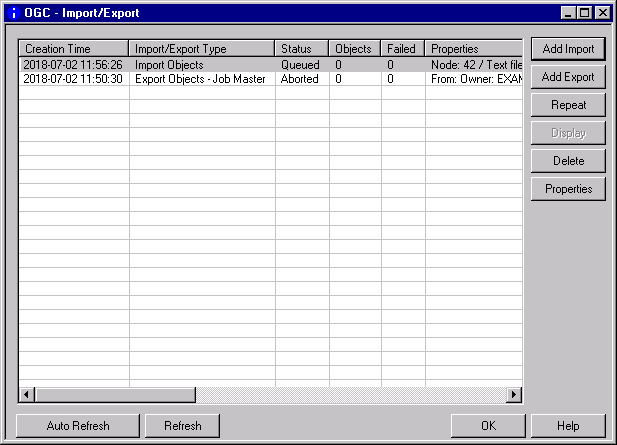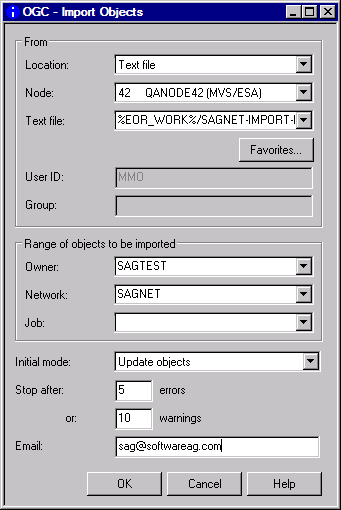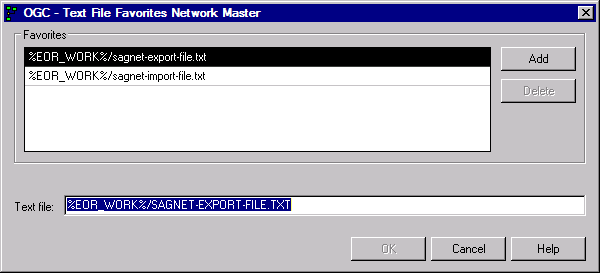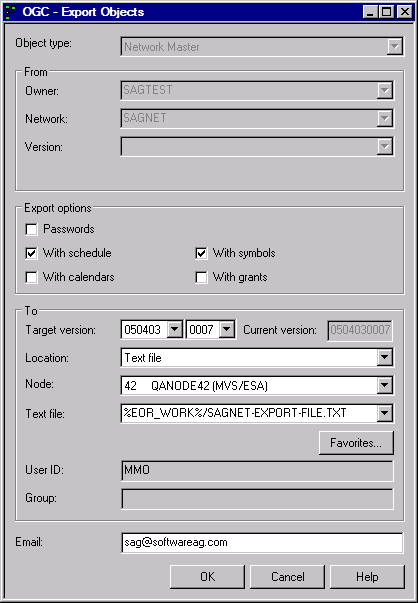This document covers the following topics:
Importing and exporting objects via Entire Operations is only possible if the Monitor is running. All import and export operations are executed asynchronously.
This section provides information on the process of importing objects and handling errors.
| Warning: You should use the import function with care. It can delete definitions from or add definitions to your database. |
 To import objects
To import objects
In the object workspace, select the General node and choose from the context menu.
A user-specific Import/Export window similar to the example below opens:

The window lists all processing requests submitted for the objects to be imported (or exported). The list is empty if no requests exist.
The list indicates the current processing status and whether a request has been completed successfully.
The columns and functions available in the Import/Export window are described in Columns: Import/Export Window and Functions: Import/Export Window, respectively.
Choose Add Import.
(See Exporting Objects for export instructions.)
An Import Objects window similar to the example below opens:

The input fields available are described in Fields and Options: Import Objects Window.
If required, specify the range of objects to be imported from the specified import file and change the import option.
Choose when you are finished.
The window closes and the new import request is listed in the Import/Export window.
If the import operation is successful, the objects are added, modified or deleted in the appropriate object node(s) of the object workspace.
The syntax that applies to the entries in the import file is explained in Syntax in Import/Export Files and Object Processing Rules.
This section covers the following topics:
The Import/Export window provides the following columns:
| Column | Description | |
|---|---|---|
| Creation Time | Date and time when the import or export request was added. | |
| Import/Export Type | Operation to be
performed (Import Objects or Export Objects) and the
type of object selected for processing.
|
|
| Status | Status of the import or export operation: | |
Queued |
Import/export request is queued for processing. | |
Running |
Operation is in progress. | |
Completed |
Operation performed successfully. | |
Aborted |
Operation failed. | |
| Objects | Number of objects that were processed successfully. | |
| Failed | Number of objects that were not processed successfully. | |
| Properties | Properties settings
used for processing a selected request.
These settings correspond to the information shown in the Import Objects or Export Objects window. |
|
The Import/Export window provides the following functions to add import and export requests, obtain information on a selected request or remove a request from the list:
| Function | Description |
|---|---|
| Add Import | Opens the Import Objects window to specify the object you want to import. |
| Add Export | Opens the Export Objects window to specify the object you want to export. |
| Repeat | Repeats an import or export
operation.
See also Repeating an Import or Export Operation. |
| Display | Displays an
extended
log file for a completed or aborted import or export operation
listed in the window to view information and error messages (if any) on the
import or export process.
For more information, see Extended Log in the User's Guide. |
| Delete | Deletes a single or multiple requests
(not the resulting output) selected in the table of the
Export
Objects window to clear the list queue after a request
has been processed.
See also Retention Period for Import/Export Requests from Entire Operations GUI Client. |
| Properties | Displays the properties of a request which correspond to the information shown in the Import Objects or Export Objects window. |
The fields and options provided in the Import Objects window are described in the following table.
All values entered in this window are checked for their validity. If a Natural object is specified as import file, the file existence is also checked.
| Field | Description | |
|---|---|---|
| Location | The location of the
file to be imported.
Select either of the following options: |
|
| Natural source | Import from a Natural text object. See also the fields Library and Member prefix. | |
| Text file | Import from a text file. | |
| Library | Only for
Natural
source locations.
Enter the name of the library, where the Natural objects reside. |
|
| Member prefix | Only for
Natural
source locations.
Enter the prefix (maximum is 5 characters) of the
names of the objects to be imported, or enter the name of a rejected object
( For explanations of prefix, see the description of the Member prefix field used for the export operation. |
|
| Node | Only for Text
file locations.
Enter the name of the node through which the specified text file can be accessed. The text file must exist. |
|
| Text file | Only for Text
file locations.
Enter the name of the text file to be used for the import operation. |
|
| Favorites | This option button is only available if Text file is selected: see Using Favorites for Text Files. | |
| User ID | Only for Text
file locations.
Enter the default user ID if defined for the specified node. |
|
| Group | Only for Text
file locations.
Enter the UNIX group or Windows domain (optional) if defined for the specified node. |
|
| Initial Mode | The mode to be used
when starting to import the object definitions contained in the file to the
Entire Operations database. The mode can change during import if the file
contains mode commands.
Select one of the following options: |
|
| Check Objects | Check syntax of objects. | |
| Add objects | Add objects to the database (default). | |
| Update objects | Update objects on the database. | |
| Replace objects | Replace objects on the database, or add them if they do not exist. | |
| Delete objects | Delete object from the database. | |
| Owner
Network Job |
These fields can be used to define a range of objects to be imported from the import file. | |
| Enter the required
owner, network and job.
Notes:
|
||
| Stop after ... errors | Enter the number of
errors which can occur before terminating the import process.
Valid range: 1 to 99999. Default: 5. |
|
| or ... warnings | Enter number of
warnings which can occur before terminating the import process.
Valid range: 1 to 99999. Default: 10. |
|
You can define favorite text files to be used by default for both the import operation and the export operation.
 To select, add and delete favorite text files
To select, add and delete favorite text files
In the Import Object or Export Objects window, select Text file for Location and enter a name (or name range) in the Text file field, select a name from the drop-down list box, or leave the field blank.
Choose .
A Text File Favorites dialog similar to the example below opens:

The name (if entered) in the Text file field of the Import/Export Objects is contained in the Text file field of the dialog.
To add a favorite file:
In the Text file field, enter the name of a text file (maximum is 250 characters) or change the name already entered in the field.
Choose .
The new file is added to the Favorites list.
The Add button is deactivated if the maximum of five file names is reached or if the specified name is already contained in the Favorites list.
If the maximum number of file names is reached, you have to a delete an existing file before you can add a new one.
To select a favorite file:
From the Favorites list, select the file you want to use for the current import/export operation.
The file name is copied into the Text file field of the dialog.
To remove favorite files:
In the Favorites list, select one or more file names and choose Delete.
The selected file is removed from the Favorites list.
Choose OK to save your changes or double-click on a file in the Favorites list.
(Cancel cancels any changes. A confirmation window asks you to save the changes if the Show confirmation dialog option is selected in your user profile.)
The changes are saved and the Text File Favorites dialog closes.
The file entered in the Text file field of the Text File Favorites dialog is copied into the Text file field of the Import/Export Objects and is used for the current import/export operation.
If at least one error occurs within the object, the whole object is rejected. Errors and warnings are counted for single objects during the import. If the error or warning limit is reached, the whole import is cancelled.
Whenever an object is rejected, it is saved with the prefix
ERR- and an ascending number (ERR-0001,
ERR-0002, and so on) in the library specified for the import
operation. These objects contain the rejected object and the errors which
caused the rejection. The error text is written directly above the line which
contains the error.
Note:
You have to specify a Natural library name for storing these
objects. Otherwise, errors are only protocolled in the job log.
In addition, a header is written to the object informing you about the:
Number of errors or warnings in this object;
User who started the import;
Date and time when the object was rejected.
(See also Date and Time Formats in the User's Guide.)
You can edit these error objects manually and import them again.
Possible error causes and advice about fixing errors are described in the following section.
- Error Severity
There are three levels of error severity:
Warnings
Warnings are displayed, but do not cause the rejection of the object.Errors
Errors cause rejection of the object but do not cause termination of the import. Import continues with the next object within the file, if the error/warning limit has not been reached.Fatal Errors
Fatal errors are serious problems which cannot be ignored and cause immediate termination of the import. A fatal error occurs, for example, when it is impossible for the parser to continue at a new point.- Causes of Errors - Syntax
If errors or warnings occur during import, some of the possible causes could be syntax errors, for example:
A value has invalid format.
A character in a numeric field.
A keyword was invalid or non-existing.
The value of a field exceeds valid length.
A non-existing object type was specified.
These errors should not occur when importing an unchanged exported object. If you edit the exported object online or create a new object manually, these errors could occur.
- Causes of Errors - Logical Errors
If errors or warnings occur during import, some of the possible causes could be logical errors, for example:
Value has correct syntax but does not meet the requirements of Entire Operations.
A Job type is specified, which is not allowed in Entire Operations.
The field has a special range (e.g. only
YorN).Adding an object to Entire Operations which already exists.
Deleting a non-existing object.
 To repeat a failed import operation
To repeat a failed import operation
Correct all erroneous ERR- objects as
described in the previous section.
If the settings from the import window are not suitable, specify the desired import mode in the first line of the first error object.
Start a new import as described in
Importing Objects with the
location NAT (Natural source) for all objects prefixed with
ERR-.
 To delete single or multiple import/export requests
To delete single or multiple import/export requests
From the table in the Import/Export window, select one or more requests and choose from the context menu or press DELETE.
The selected import and/or export requests are removed from the table.
This section explains the export of objects and their key fields.
Exporting an object can invoke the transformation of records from the Entire Operations database into an external format.
The following functions are available to export objects:
The Export function for a selected object node: selects and exports all objects contained in this node.
The Export function in a maintenance window: exports current settings of Entire Operations defaults, message, network activation definitions and import or export operations.
This section provides instructions for all export options.
 To export node items
To export node items
In the object workspace, select a node or a node instance and choose from the context menu.
An Export Objects window similar to the example below opens:

Depending on the node or node instance selected, the From section contains different output fields that indicate the source objects used for the export.
Select the required options and the location where you want to export the object(s). Depending on the location selected, additional fields appear in the To section of the window.
All input fields and options available in the Export Objects window section are described in Fields and Options: Export Objects Window.
When you are finished, choose .
A user-specific Import/Export window opens.
The window contains a list of all processing requests submitted for the objects to be exported (or imported). If you selected a node in Step 1, requests for all objects contained in this node are listed.
The list indicates the current processing status and whether a request has been completed successfully.
The columns and functions available in the Import/Export window are described in Columns: Import/Export Window and Functions: Import/Export Window, respectively.
Choose .
All objects listed in the Import/Export window are exported in the previously specified format.
If the export process is successful, the data collected for the listed objects is output in the specified export file.
The syntax that applies to the entries in the export file is explained in Syntax in Import/Export Files and Object Processing Rules.
 To export objects from the General node
To export objects from the General node
In the object workspace, select the General metanode and choose Import/Export from the context menu.
In the Import/Export window, choose Add Export.
(See Importing Objects for import instructions.)
An Export Objects window similar to the example shown earlier opens.
Proceed with Steps 2 to 4 in Exporting Node Items.
 To export current Entire Operations defaults, message or
network activation settings
To export current Entire Operations defaults, message or
network activation settings
In the object workspace, select the Administration metanode and choose Entire Operations Defaults from the context menu.
(See also Accessing Default Settings for Entire Operations in the Administration documentation.)
Or:
In the object workspace, select the
metanode, choose
from the context menu and open
the tabbed page Global User Exits.
(See also Global Messages and Exits in the Administration documentation.)
Or:
In the object workspace, select the
General metanode and choose Show
Messages from the context menu.
(See also Viewing Mailbox Messages in the User's Guide.)
Or:
In the object workspace, select the
General metanode, an owner or a network instance and
choose from the context menu.
(See also Viewing and Maintaining Next Network Activations in the User's Guide.)
Or:
From a maintenance window (for example,
Show
Messages and Requests) choose
Export.
An Export Objects
window opens where the type of settings to be exported is indicated
in the Object type field, for example,
Defaults or Mailbox Entry.
Proceed with Steps 2 to 4 in Exporting Node Items.
The fields and options provided in the Export Objects window are described in the following table.
| Field/Option | Description | ||
|---|---|---|---|
| From: | |||
| Depending on the Object type selected, owner, network, network version and job used for the export are displays as output fields in the From section. | |||
| Object type | Object type to be
exported.
See also Object Type to be Exported: Key Fields of the Objects. |
||
| ... | The remaining From fields differ according to the object type selected. | ||
| To: | |||
| Target Version | Entire Operations version to be used as the target version for the export: see Target and Current Versions. | ||
| Location | Location of the file
that contains the export data.
Select either of the following options: |
||
| Natural source | Export to a Natural
text object.
See also the fields Library and Member prefix. |
||
| Text file | Export to a text file. See also Using Favorites for Text Files. | ||
| Node | Only for Text
file locations.
Enter the name of the node through which the specified text file can be accessed. The text file must exist. |
||
| Text file | Only for Text
file locations.
Enter the name of the text file to be used for the export. |
||
| Favorites | This option button is only available if Text file is selected: see Using Favorites for Text Files. | ||
| User ID | Only for Text
file locations.
Enter the default user ID if defined for the specified node. |
||
| Group | Only for Text
file locations.
Enter the UNIX group or Windows domain (optional) if defined for the specified node. |
||
| Library | Only for
Natural
source locations.
Enter the name of the library that contains the Natural text object used for the export operation. |
||
| Member prefix | Only for
Natural
source locations.
Enter the prefix (maximum is 5 alphanumeric characters) of the Natural text object(s) that are to store the export data. The prefix is padded with hyphens ( One or more text objects with the specified prefix are
created depending on the amount of data to be exported. For example: The prefix
|
||
| Append/New/Replace | Only for
Natural
source locations.
Determine how to handle the export data contained in the Natural text object(s) specified with the prefix in the Member prefix field. Possible option settings are: |
||
| Append |
Select this option to append the data to be exported to the specified text object. Text object with the specified prefix must exist. |
||
| New |
Select this option to save the data in a new text object. If a text object with the specified prefix already exists, an appropriate message is returned. This is the default setting. |
||
| Replace | Select this option to replace the data in the specified text object. | ||
| Passwords | Only for object types
which contain passwords (e.g., password of a protected data set).
Possible radio button settings: |
||
| selected | Export passwords. | ||
| not selected | Do not export passwords. | ||
| with Schedules | If you also export the
schedules, the imported networks will get the same schedule definitions as the
exported networks. (They can be modified after the import.)
Possible radio button settings: |
||
| selected | Export schedules (default). | ||
| not selected | Do not export schedules. | ||
| with Calendars | If you export
object(s) with calendars, all referenced calendars will be exported after
objects, each calendar once.
Possible radio button settings: |
||
| selected | Export calendars. | ||
| not selected | Do not export calendars (default). | ||
| with Symbols | If you export
object(s) with symbols, all referenced symbol tables will be exported after
objects, each symbol table once.
Possible radio button settings: |
||
| selected | Export symbols. | ||
| not selected | Do not export symbols (default). | ||
| with Grants | If you export
networks, you can determine whether access rights granted to users/owners in
the source environment are also exported.
Possible radio button settings: |
||
| selected | Export granted access rights. | ||
| not selected | Do not export granted access rights (default). | ||
- Target and Current Versions
The version in the Target Version and Current Version fields of the Export Objects window have the format
vvrrssffff, where:
vvrrssValid Entire Operations version with leading zeros, for example, 050501 for Entire Operations Version 5.5.1. ffffOne- to two-digit cumulative fix number (if available) with leading zeros, for example, 0001. Valid input values for Target Version are from 0501010014 to the current (or next)
vvrrssffffversion. The highest allowed value is preset as default.You can select a version and cumulative fix from the drop-down list boxes.
The Current Version read-only field indicates the Entire Operations version installed in your current environment.
The key fields you have to specify for any Object name you want to export are described in the following table.
The object types listed in the following table are used in an import or export file. They correspond to the object types (terms in parentheses in the table below) you can select from the Export Objects window opened when performing the Import/Export function from the General node.
| Object Type | Key Field 1 | Key Field 2 | Key Field 3 | Key Field 4 | Remark |
|---|---|---|---|---|---|
| OWNER
(Owner) |
Owner | This exports all objects which belong to a specific owner. | |||
| NETWORK-MASTER
(Network Master) |
Owner | Network | Version | ||
| NETWORK-VERSION-USAGE
(Network Version Usage) |
Owner | Network | |||
| JOB-MASTER
(Job Master) |
Owner | Network | Version | Job | |
| EOJ-CHECK-MASTER
(EOJ Check Master) |
Owner | Network | Version | Job | |
| DESCRIPTION
(Description) |
Owner | Network | Version | Job | A hyphen (-) used
instead of a job name exports the description of the network.
|
| SCHEDULE
(Schedule) |
Owner | Schedule | Schedule = Network | ||
| CALENDAR
(Calendar) |
Owner | Calendar | |||
| TO-ACTIVATE
(To Activate) |
Owner | Network | Version | Job | Job is optional. |
| SYMBOL-MASTER
(Symbol Master) |
Owner | Symbol table | |||
| SYMBOL-VERSION-USAGE
(Symbol Version Usage) |
Owner | Symbol table | |||
| MAILBOX-DEFINITION
(Mailbox Definition) |
Mailbox | ||||
| MAILBOX-ENTRY
(Mailbox Entry) |
Mailbox | ||||
| NODE-DEFINITION
(Node Definition) |
Node | ||||
| RESOURCE-DEFINITION
(Resource Definition) |
Resource | ||||
| RESOURCE-PREREQ
(Resource Prereq) |
Owner | Network | Version | Job | |
| USER-DEFINITION
(User Definition) |
User ID | ||||
| DEFAULTS
(Defaults) |
Library | ||||
| CONDITION-ACTIVE
(Condition Active) |
Owner | Network | Version | The export will be performed for all active runs of the condition. | |
| GLOBAL-EXIT
(Global Exit) |
All global exits will be exported. |
 To repeat an import/export operation
To repeat an import/export operation
From the table in the Import/Export window, select a completed import or export and choose Repeat.
An Import Objects or Export Objects window opens with the properties settings of the previous import or export, respectively.
If required, change the current settings. The fields and options are explained in Fields and Options: Import Objects Window and Fields and Options: Export Objects Window, respectively.
Choose OK.
The request is added to the table and queued for processing.
The same applies as stated for an initial import or export operation.
Data generated for import and export requests from Entire Operations GUI Client is retained for the number of days specified for active jobs in the Retention Periods of the Entire Operations default settings (see Defaults for Time Ranges in the Administration documentation).
Older import and export requests listed in the Reporting window of Entire Operations GUI Client are automatically removed after this period or during the next database cleanup (see also the Administration documentation).